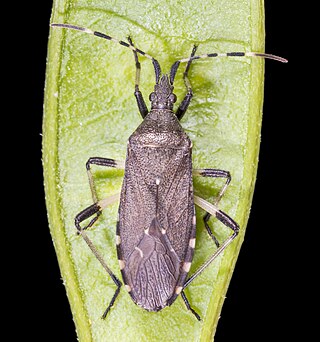
The firebrat is a small insect, in the order Zygentoma.

Pentatominae is a subfamily of Pentatomidae, a family of shield bugs. This subfamily is the largest one within the Pentatomidae, having 4937 species classified in 938 genera. Species in this subfamily are phytophages and several of them are considered agricultural pests. Some invasive pentatomines such as Halyomorpha halys and Bagrada hilaris have been considered household pests. Higher systematics of the group have been revised by Rider et al.

Nysius is a genus of false chinch bugs in the family Lygaeidae. At least 100 described species are placed in Nysius.

Lepismatidae is a family of primitive wingless insects with about 190 described species. This family contains the two most familiar members of the order Zygentoma: the silverfish and the firebrat. It is one of five families in the order Zygentoma.

The Microphysidae are a very small family of true bugs, comprising only 5 extant genera.

Rhynocoris is a genus of assassin bug, family (Reduviidae), in the subfamily Harpactorinae. Species are recorded from Asia, mainland Europe, Africa and North America.

Phylinae is a subfamily of the plant bug family Miridae. Species of this family are found worldwide.

Helobata is a mostly Neotropical genus of water scavenger beetle in the family Hydrophilidae. It contains 13 described species, one of which is broadly distributed, reaching North America.

Edvin Leonard Bergroth was a Finnish engineer, businessman and vuorineuvos.
Thermobia aegyptiaca is a species of silverfish in the family Lepismatidae. The species was described by Hippolyte Lucas in 1840 based on specimens collected in Egypt. Thermobia aegyptiaca is distributed in Africa and the eastern Mediterranean Basin.

Halyomorpha is a genus of shield bugs in the subfamily Pentatominae and tribe Cappaeini, erected by G. Mayr. This genus probably has an Asian centre of origin, but Halyomorpha halys, the brown marmorated stink bug, is an invasive species with a world-wide distribution.

Myodochini is a tribe of dirt-colored seed bugs in the family Rhyparochromidae. There are more than 80 genera and 370 described species in Myodochini.

Aneurus is a genus of flat bugs in the family Aradidae. There are at least 60 described species in Aneurus.
Botocudo is a genus of dirt-colored seed bugs in the family Rhyparochromidae. There are at least 30 described species in Botocudo.

Gastrodes is a genus of dirt-colored seed bugs in the family Rhyparochromidae. There are about 14 described species in Gastrodes.

Dicranocephalus is the sole genus of true bugs in the family Stenocephalidae. There are about 30 described species in the genus Dicranocephalus.

Nagusta is a genus of Murder bugs in the family Reduviidae.

Tessaratoma is a genus of bugs in the family Tessaratomidae. There are more than 20 described species in Tessaratoma.

Vibertiola is a genus of assassin bugs in the tribe Rhaphidosomatini. Species have been recorded from southern Europe and North-West Africa.

















